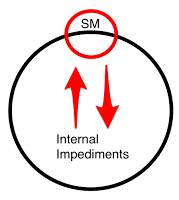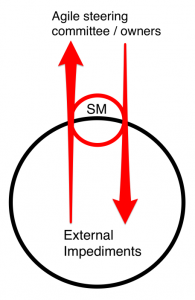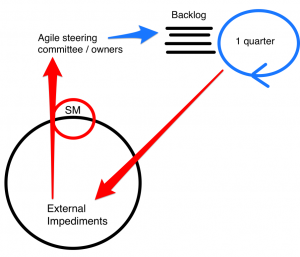In theory, it sounds pretty straightforward: an Agile team identifies an impediment and either solves for it or the Scrum Master takes it upon himself to remove it. Easy, right?
Internal Impediments
As long as it’s within the team’s or Scrum Master’s control to successfully deal with an impediment, this is a viable approach and
hopefully most impediments fall into this category. (Let’s call these “internal impediments”.)
hopefully most impediments fall into this category. (Let’s call these “internal impediments”.)

External Impediments
The problem is, there are these other impediments that are outside the team’s or Scrum Master’s control (let’s call these “external dependencies” because their root cause lies outside the team). What happens to those? Scrum doesn’t really say and is missing explicit mechanisms and ceremonies to deal with them, so it’s often left to the Scrum Master to figure this out.
During an Agile transformation, when a lot attention is paid to the maturing Agile teams and the overall progress, there is – in most cases – a person or a group of people in place who “own” the transformation. This group is a good audience for helping the teams resolve external impediments because it is motivated and empowered to keep the transformation on track.

In organizations which have been Agile for some time (maybe several years), often there is no clear ownership of “Agility” any more and it’s (hopefully) just part of an organization’s DNA and status quo. In these cases, the Agile steering committee has often-times already been disbanded and with that, there’s now a void in that a Scrum Master with external dependencies has no clear audience to get resolution. He may improvise, try to track down various involved stakeholders and affect organizational change himself, but, due to his lack of organizational influence, may not get very far. In those cases, these external dependencies often remain unsolved and the teams tend to get frustrated and numb to the impediments that never get taken care of. They feel the lack of organizational support, give up and often just “deal with it”.

What to do?
So what is the solution? During an Agile transformation and beyond, an organization should have a clearly identified group of Agile stakeholders, people who feel responsible for the success of Agile in the organization. Then there should be an explicit process for dealing with external dependencies that involves those stakeholders who will hopefully take ownership of these hairier organizational impediments.
That said, organizations aren’t always great at putting these mechanisms in place and might require to be given more specific guidance and tools. That’s where AgilityHealth (an Agile assessment and growth tool) can provide the necessary structure:
- Resulting from regular strategic retrospectives, external impediments are identified and clearly flagged as “organizational growth items”
- Those impediments are reviewed quarterly with an explicitly defined leadership group
- That group pulls a number of these impediments from the growth backlog and commits to resolving them
- Impediments are dealt with and resolved (likely in collaboration with the team)
- After 3 months, the leadership group is asked to review with the teams the progress that has been made (this doesn’t imply that impediments shouldn’t be resolved faster if possible).
- The cycle starts over.

In essence, this process & tool create a new macro feedback loop as well as a quarterly “impediment sprint” with leadership. (In larger organizations, there could be several concentric layers of impediment sprints, e.g. involving portfolios first and then the overall organization.) Since this approach makes explicit the process, its cadence, the process participants and roles, it helps fill the gap that Scrum and other team-based Agile frameworks leave unfilled. Institutionalizing the process will provide accountability and heart beat that ensure these external impediments aren’t left unresolved.
I’m hoping this blog post has helped identify different types of impediments that need to be treated differently and will encourage organizations to be more deliberate with regards to how to deal with external impediments.
Great blog Rene! Creating this new organizational level feedback loop that was missing was one of the key goals from creating AgilityHealth, teams can only grow so much before they hit many issues they can't resolve themselves. Additionally, the iteration cycles keep them tactically focused on execution that they rarely slow down enough to even realize or say something about key bottlenecks or opportunities that could greatly impact their performance. Thanks for writing this!